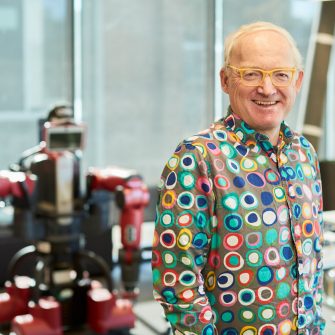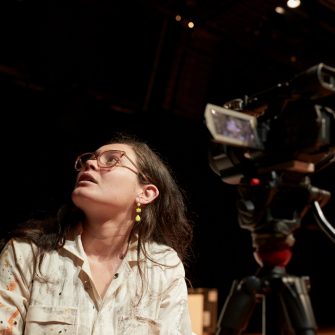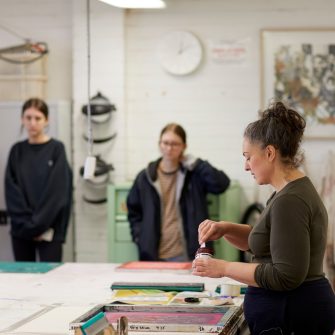Graduate Diploma in Animation and Visual Effects
- Commencing Terms
- Term 1, 2 & 3
- Duration
- 1 year(s)
- Delivery Mode
- Face-to-face (includes blended)
- Campus
-
Paddington
- Codes
- Program code 5319
- CRICOS code 113671K
-
2026 Indicative first year full fee
- $39,000*
-
2026 Indicative full fee to complete degree
- $39,000*
-
2026 Indicative first year full fee
- $48,500*
-
2026 Indicative full fee to complete degree
- $49,500*
Application closures for 2026
Undergraduate programs for 2026 intakes are closed for New Overseas Student Commencement (NOSC) applications. Applications for postgraduate programs remain open. Find out if this closure applies to you.
- Overview
- Entry requirements
- What will I study?
- Future careers
- How to apply
- Fees & Scholarships
Overview
The Graduate Diploma in Animation and Visual Effects is designed for graduates and professionals both within and outside of the animation and visual effects industry who aim to enter or upskill in this growing and evolving field.
This shortened and customisable program combines technical, conceptual, creative and professional skills to enable you explore your interests and develop as a technical professional. You’ll have the opportunity to explore and develop your artistic vision in the company of a diverse community of artists and designers.
Diversify your existing knowledge and skills or develop the capabilities to move into this new and exciting sector with access to world-class facilities and guidance from academics with a wealth of industry experience.
Key features
Holistic artistic development
Informed by the latest industry developments, you'll learn a variety of technical processes and approaches as well as creative and conceptual skills that prepare you to work in a variety of roles across and beyond the creative pipeline. From pre-visualisation to output, you'll combine hands on skills with a deep understanding of screen aesthetics and attention to broader social, cultural and technological contexts. This dynamic combination of practical and contextual learning is designed to build your ability to think laterally, adapt across disciplines, and solve creative, conceptual and technical problems as an artist.
Agility and leadership for an evolving future
You’ll gain in-demand capabilities across teamwork, resilience and communication, helping you become a sought-after professional in the animation and visual effects sector and beyond. This complementary skillset will set you up to be agile, adaptable, future-oriented and ready to drive and lead change in a rapidly evolving animation and VFX industry into the future, as well as in new and emerging sectors using digital visualisation technologies.
Inclusive and flexible learning environment
Immersed in a supportive and inclusive community at UNSW Art & Design, you’ll develop your practice alongside fellow artists and designers of the future. As part of this dynamic and diverse community, you’ll grow creatively, share experiences and expand your peer network. Our flexible study options and pathways mean that you can learn at your own pace and develop a portfolio or showreel that aligns with your creative vision and career ambitions.
Why study at UNSW?
- Join a global top 20 university (QS World University Rankings, 2024–2026).
- Develop as an artist on campus at UNSW Art & Design, a campus dedicated to creativity at the centre of Sydney’s creative sector.
- Gain a prestigious Go8 education at a university dedicated to shaping a generation of socially conscious change-makers and leaders across art and design.
- Access flexible study options. Our timetables are designed to allow you to work while studying, with the added opportunity to gain industry feedback and real-world work experience through internship options. Depending on your experience, you can also fast-track your degree and graduate in one year.
- Our research in digital media has been rated well above world standard four times since 2010 by the Australian Research Council (ERA ranking 5).
- Tap into a diverse array of creative expertise with lectures from world-class companies featured at venues, festivals, museums and galleries in Australia and across the world, including Weta Digital, Animal Logic, DreamWorks Animation, Rising Sun Pictures, Cutting Edge and more.
- Be inspired by UNSW Art & Design's extensive alumni network of digital media trailblazers and innovators, including Duncan Ramson (CEO at The Endless Co.), Lynette Wallworth (Emmy award-winning filmmaker and artist), Jack Condon (Evangelist at Epic Games), Patrick Younis (3D interaction and VFX artist) and more.
Want to see more from UNSW Arts, Design & Architecture?
Entry requirements
Admission to the Graduate Diploma in Animation and Visual Effects requires a Bachelor’s degree in any field. Applicants who apply without a Bachelor’s degree or with a Bachelor’s degree completed more than 10 years ago can be admitted to the Graduate Certificate on a case-by-case basis by the Program Director, on the basis of professional experience.
English language requirements
You may be asked to provide evidence of your English proficiency to study at UNSW depending on your educational background and citizenship. English language skills are vitally important for coping with lectures, tutorials, assignments and examinations - this is why UNSW requires a minimum English language competency for enrolment.
If you’re completing an Australian Year 12 qualification (e.g. NSW HSC or equivalent), you do not need to provide anything extra to prove your proficiency. Your qualification will be used as evidence of your English proficiency.
If you do need to provide evidence of your English proficiency, this will be indicated in your application. You can prove this by providing evidence that you meet one or more of the following criteria:
- English language tests and university English courses
- Prior study in the medium of English
- Other qualifications
If you need to improve your English skills before you start your degree, UNSW College’s Academic English Programs are for you. The programs are suitable for various English levels and help you prepare for university studies and life in Australia.
For more details, visit the English Language Requirements page.
Admission to the Graduate Diploma in Animation and Visual Effects requires a Bachelor’s degree in any field. Applicants who apply without a Bachelor’s degree or with a Bachelor’s degree completed more than 10 years ago can be admitted to the Graduate Diploma on a case-by-case basis by the Program Director, on the basis of professional experience.
English language requirements
You may be asked to provide evidence of your English proficiency to study at UNSW depending on whether you are from an English-speaking background or non-English speaking background. English language skills are vitally important for coping with lectures, tutorials, assignments and examinations - this is why UNSW requires a minimum English language competency for enrolment.
If English is not your first language, you’ll need to provide proof of your English proficiency before you can be given an offer to study at UNSW. You can do this by providing evidence that you meet one or more of the following criteria:
- English language tests and university English courses
- Prior study in the medium of English
- Other qualifications
If you need to improve your English skills before you start your degree, UNSW College’s Academic English Programs are for you. The programs are suitable for various English levels and help you prepare for university studies and life in Australia.
For more details, visit the English Language Requirements page.
Check the specific English language requirements for this program
What will I study?
UNSW is introducing a new academic calendar from 2028.
We are moving to a new flex-semester calendar. What does this mean for your studies?
Program structure
The Graduate Diploma in Animation and Visual Effects offers a customisable structure with flexible entry and exit points as well as full-time and part-time study options.
Comprising three core studio courses, three core contextual courses and two prescribed elective courses, you can complete the graduate diploma in one year full-time, or over a longer period if you’d prefer.
Full program structure
Each university year at UNSW has three terms and an optional summer study period.
You can study full-time or part-time. Depending on how you plan your study load, you can fit two or three courses into a term and one course in a summer term.
The Graduate Diploma in Animation and Visual Effects has three main components: a series of core studios that develop essential skills, contextual courses that complement your creative skillset, and prescribed electives that give you options to build your portfolio of skills and knowledge in specialised areas of practice.
Core studio courses
In the core studios, you’ll learn to integrate fundamental aspects of animation, 3D modelling and VFX compositing into increasingly complex projects.
Examples of topics explored through the core studio courses include:
- Animating movement, storyboarding and pre-visualisation
- 3D Visualisation and modelling
- VFX compositing, matte painting and camera tracking
Contextual courses
Through a series of contextual courses, you’ll build a complementary set of capabilities in teamwork, communication, research and leadership, as well as deepen your understandings of screen aesthetics and the key ideas and debates that are shaping this field.
Courses include:
- Digital aesthetics
- Research methodologies
- Communication skills
Prescribed electives
You’ll choose from the following studio-based elective courses to focus on specific areas of animation and visual effects practice:
- Motion capture
- Rigging
- Creature and character design
- Procedural FX
- Real-time and virtual production
- Digital cinematography
Example plan
Below is an example of what you could study in a one-year standard full-time study plan:
First term
- 1 core studio course
- 2 contextual courses
Second term
- 1 core studio course
- 1 prescribed elective course
Third term
- 1 core studio course
- 1 contextual course
- 1 prescribed elective course
Future careers
The Graduate Diploma in Animation and Visual Effects will help you upskill, build your portfolio and develop the creative and technical skills to enter a rapidly growing Australian and global creative industry. Gain the qualifications you need to kick start your creative career in a vibrant industry with roles and career opportunities across the creative pipeline.
Visualise the future
Hear from alum, Pat Younis and Scientia Associate Professor, John McGhee on the dynamic and growing animation and VFX industry.
Potential careers
- Animator
- 3D animator
- 3D generalist
- CG effects artist
- Creature effects artist
- Concept artist
- Storyboard artist
- Texture artist
- Visual effects artist
- Visual effects compositor
- VFX supervisor
- Matte painter
- Media arts practitioner
- Motion designer
- Art director
- Post-production artist
- Virtual production artist
- Game developer
- Game designer
- Layout artist
How to apply
Applications must be submitted through our Apply Online portal. We encourage you to submit your completed application as early as possible to ensure it will be processed in time for your preferred term. Some high-demand programs and Faculties with limited places may have an earlier application deadline or commencement date. Find out more.
Ready to start your application?
For most international students, applications are submitted via our Apply Online service. We encourage you to submit your completed application as early as possible to ensure it will be processed in time for your preferred term.
Some high-demand programs with limited places, may have an earlier application deadline or may have an earlier commencement date. For details, visit the international admissions information page.
Ready to start your application?
Fees & Scholarships
*Fees are subject to annual review (or when required) by the University and may vary accordingly.
Indicative fees are a guide only and have been calculated based on the typical enrolment patterns of students undertaking the program. The indicative fees listed here is an estimate for tuition only and excludes non-tuition fees and charges. The amount you pay will vary depending on the calendar year of enrolment, the courses you select and whether your study load is more or less than 1 Equivalent Full Time Student Load (48 units of credit (UOC) per year).
You should not rely on indicative fees as fee increases are assessed when required and may exceed the indicative figures listed here. Actual fees are calculated on enrolment. More information on fees can be found at the UNSW fees website.
*Fees are subject to annual review by the University and may increase annually, with the new fees effective from the start of each calendar year. The indicative fees listed here are based on an estimated average and are for tuition only, other fees and charges are not included. The amount you pay will vary depending on the calendar year to enrol, the courses you select and whether your study load is more or less than 1 Equivalent Full Time Student Load (8 courses per year).
Indicative fees are a guide for comparison only based on current conditions and available data. You should not rely on indicative fees. More information on fees can be found at the UNSW fees website.
Indicative fees to complete the program have been calculated based on a percentage increase for every year of the program. Fee increases are assessed annually and may exceed the indicative figures listed here.
Indicative fees to complete the program include tuition plus an estimate of study-related costs of approximately $1,000 per year. To find out more about other costs, visit UNSW International.
Scholarships
At UNSW, we award over $83 million in scholarships each year. We pride ourselves on rewarding excellence and making university accessible to students from all walks of life. Whether you’re a domestic or international student, our range of scholarships, prizes and awards can support your journey.
Progress starts here – at a world-leading university

Top 20 Worldwide
Ranked in the global top 20 for three consecutive years
QS World University Rankings, 2024–2026

Winner of the AFR Most Employable University Award six years in a row
AFR Top100 Future Leaders Awards, 2020–2025

Australia's #1 for Innovation
Highest number of startups and spinouts from university-developed tech
SCOPR report, 2024





